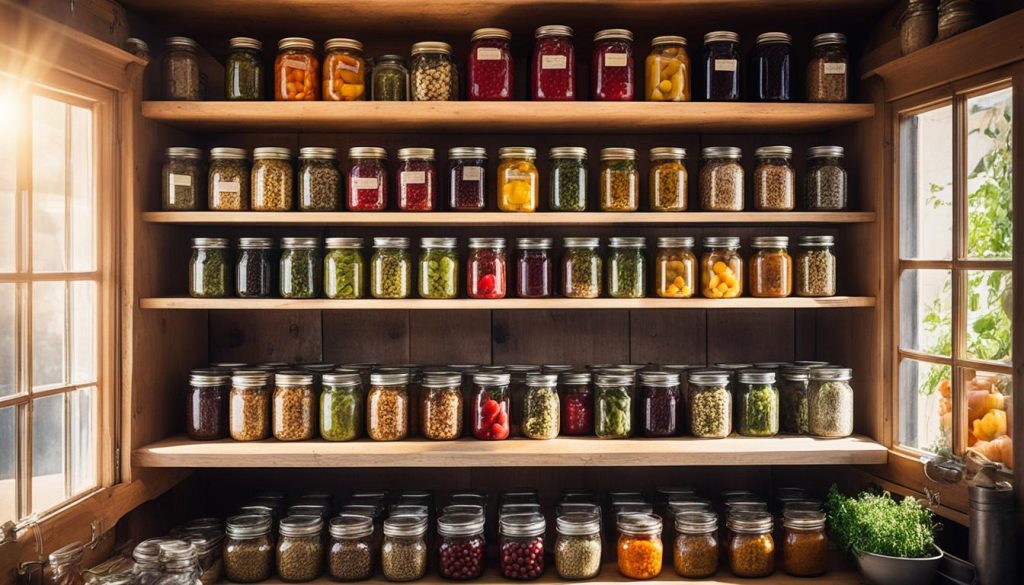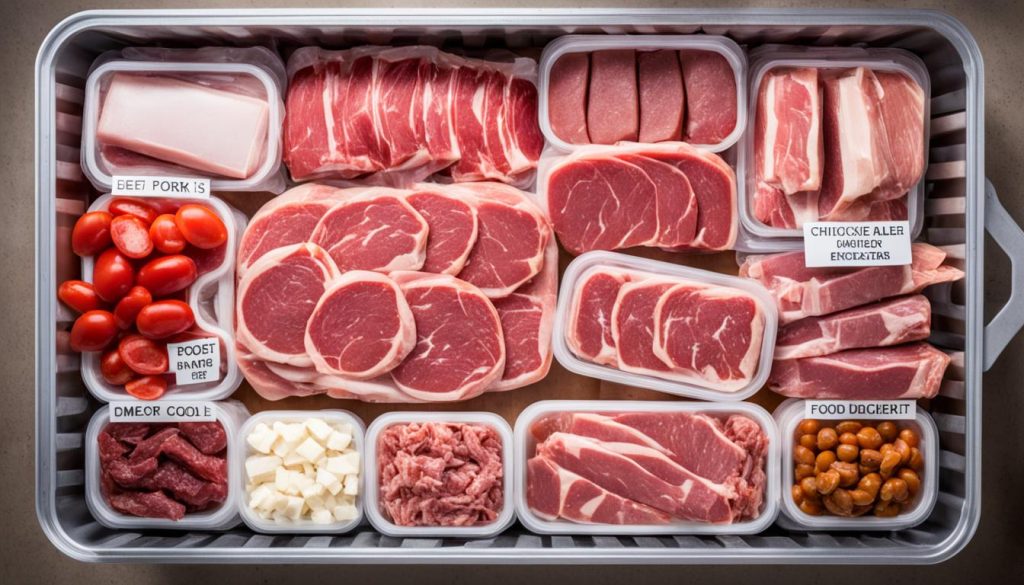Did you know that long-term food storage has been practiced for centuries, even before the advent of modern refrigeration? People across various cultures have developed different methods of preserving food to ensure their survival during times of scarcity or emergencies. While refrigeration has made long-term food storage less common today, it still plays a crucial role in emergency preparedness and cost-effective living.
Key Takeaways
- Long-term food storage has been practiced for centuries by different cultures.
- A well-stocked pantry is important for both emergency preparedness and cost-effectiveness.
- Various methods, such as canning, dehydrating, and fermenting, can be used to preserve food for long-term storage.
- By having a well-stocked pantry, you can save money by purchasing low-cost foods in bulk.
- A homestead pantry should contain a variety of foods that are commonly used, as well as extras for emergencies.
The Importance of Keeping a Pantry
Having a well-stocked pantry is not just a matter of convenience; it is essential for emergency preparedness and maintaining a family budget. By carefully stocking your pantry with essential items, you can ensure that you are prepared for unexpected situations and can also save money in the long run.
In terms of emergency preparedness, a pantry provides a crucial lifeline during times of crisis. Natural disasters, power outages, or other unforeseen events can disrupt the normal functioning of grocery stores and supply chains. Having a well-stocked pantry ensures that you have a reserve of food to sustain your family during these challenging times. It provides a sense of security and peace of mind, knowing that you have the necessary provisions to weather any storm.
In addition to emergency preparedness, a well-stocked pantry can also be a cost-effective solution for the family budget. By purchasing staple items in bulk and storing them in the pantry, you can take advantage of lower prices and discounts. Buying in bulk tends to be more cost-effective in the long run, as the unit price of the items decreases. Moreover, having a pantry allows you to buy items when they are on sale and save them for future use. This helps to reduce overall grocery expenses and allows you to allocate your family budget to other important areas.
Furthermore, having a pantry encourages better planning of garden and livestock projects. If you have space for a garden or raise animals for food, you can use your pantry to store the excess produce or meat. By doing so, you can ensure a steady supply of food throughout the year, even during seasons when fresh produce might be scarce or expensive. Storing your homegrown or homemade items in the pantry also reduces food waste and promotes self-sufficiency.
Benefits of Keeping a Pantry:
- Emergency preparedness during unforeseen events
- Cost-effective shopping by purchasing items in bulk
- Saving money by buying items on sale and stocking up
- Reducing food waste by storing excess garden produce or homemade items
- Promoting self-sufficiency by planning garden and livestock projects
Ultimately, a well-stocked pantry brings multiple benefits to your household. It provides a safety net during emergencies, helps you save money, and promotes self-sufficiency. By prioritizing your pantry and ensuring it is adequately stocked, you can be prepared for whatever challenges life may throw your way.
Stocking the Homestead Pantry
A well-stocked homestead pantry is essential for ensuring food security and self-sufficiency. It should contain a variety of functional foods that are regularly consumed by your family, as well as extras for emergency situations. Fruits and vegetables play a vital role in a balanced diet and can be stored in different ways to maintain their freshness and nutritional value for extended periods.
Preserving Fruits and Vegetables
When it comes to preserving fruits and vegetables, there are several methods to choose from:
- Canning: Canning is a popular method that involves packing fruits and vegetables into jars and processing them in a boiling water bath or pressure canner. This process seals the jars and allows the fruits and vegetables to be stored safely for an extended period.
- Dehydrating: Dehydrating is the process of removing moisture from fruits and vegetables, preserving them in a lightweight, shelf-stable form. Dehydrated fruits and vegetables can be rehydrated for use in recipes or enjoyed as nutritious snacks.
- Fermenting: Fermentation is not only a preservation method but also a way to enhance the flavor and nutritional value of fruits and vegetables. By allowing beneficial bacteria to convert sugars into lactic acid, fermentation creates a tangy and probiotic-rich product.
To ensure an adequate food supply, it is important to store a sufficient amount of fruits and vegetables based on your family’s consumption. Additionally, it is crucial to maintain a rotating stock and consume the oldest items first to prevent food waste.
Functional and Diverse Foods
A homestead pantry should be stocked with functional foods that can serve as the building blocks for nutritious meals. These foods should provide a variety of nutrients and be versatile enough to use in different recipes. By having a wide range of options, you can maintain a well-balanced diet even during challenging times.
Consider including the following foods in your homestead pantry:
- Whole Grains: Whole grains like rice, oats, quinoa, and wheat berries are rich in fiber, vitamins, and minerals. They can be stored for long periods and serve as a great source of energy.
- Legumes: Beans, lentils, and chickpeas are excellent sources of plant-based protein, fiber, and essential nutrients. They are also incredibly versatile and can be used in various dishes.
- Canned Meats and Fish: Canned meats such as chicken, beef, and fish provide a convenient source of protein. They have a long shelf life and can be used in soups, stews, sandwiches, and other recipes.
- Dried Herbs and Spices: Dried herbs and spices add flavor to your meals and can help enhance the taste of preserved foods. They also provide a range of health benefits.
- Nuts and Seeds: Nuts and seeds are packed with essential fats, protein, and micronutrients. They can be eaten as a snack or used in baking and cooking.
Having a well-stocked homestead pantry ensures that you have a diverse range of foods on hand to meet your family’s nutritional needs. It also provides peace of mind, knowing that you are prepared for unforeseen circumstances.
| Benefits of a Stocked Homestead Pantry | How to Achieve It |
|---|---|
| Ensures food security | Store a variety of functional foods |
| Provides peace of mind in emergencies | Rotate stock and consume oldest items first |
| Offers a diverse range of nutrients | Preserve fruits and vegetables using different methods |
| Reduces food waste | Maintain a sufficient amount based on family’s consumption |
Pickles, Relishes, Jams, and Jellies
When it comes to stocking your pantry, don’t forget to include a variety of pickles, relishes, jams, and jellies. These delicious additions not only provide a pop of flavor to your meals but also offer a touch of sweetness, spice, and vinegar that can enhance the overall taste experience. While they may not be considered essential for hardcore food storage, they can certainly elevate the enjoyment of your meals, whether in times of emergency or during everyday dining.
Having a selection of pickles, relishes, jams, and jellies in your pantry allows you to add a burst of flavor to a variety of dishes. Serve pickles alongside sandwiches or burgers for a refreshing crunch and tangy kick. Use relishes as a zesty topping for hot dogs or sausages. Spread jams and jellies on toast or use them as fillings for pastries and cakes. The possibilities are endless!
Not only do these sweet treats provide a burst of flavor, but they also offer a long shelf life. Jams and jellies, in particular, can last for a considerable period, making them a convenient choice for long-term storage. When stored properly in a cool, dry place, they can maintain their taste and quality for months or even years, ensuring that you always have a delectable treat on hand.
“A well-stocked pantry filled with a variety of condiments, including pickles, relishes, jams, and jellies, can transform ordinary meals into extraordinary culinary experiences.”
When selecting pickles, relishes, jams, and jellies for your pantry, opt for your favorite flavors and varieties. Experiment with different combinations to find the perfect accompaniment to your meals. Whether you prefer sweet, tangy, or spicy options, there are plenty of choices available to suit your taste buds.
Popular Types of Jams and Jellies
| Jam/Jelly Flavor | Description |
|---|---|
| Strawberry Jam | A classic favorite, made from ripe strawberries with a luscious texture and sweet taste. |
| Grape Jelly | A smooth and spreadable option made from grapes, offering a burst of fruity goodness. |
| Apricot Preserve | Delightfully tangy with chunks of apricot, perfect for spreading on toast or pastries. |
| Raspberry Jam | A delightful balance of sweet and tart flavors, made from plump, juicy raspberries. |
| Mixed Berry Jam | A medley of berries, combining the sweetness of strawberries, raspberries, and blueberries. |
The diverse range of flavors and textures offered by pickles, relishes, jams, and jellies can add excitement to your meals and provide a touch of indulgence during challenging times. By including these sweet treats in your pantry, you can ensure that even in emergencies, your taste buds are satisfied with a selection of delicious and comforting options.
Meats for Long-Term Storage
When it comes to long-term food storage, including meats in your pantry is essential for a well-rounded and nutritious stockpile. While freezing is a common method for meat preservation, canned meats offer a convenient and cost-effective alternative. Canned meats have a long shelf life and eliminate the risk of freezer failure or food spoilage, ensuring that you have a reliable source of protein during emergencies.
One of the key advantages of canned meats is their convenience. They come pre-cooked and ready to eat, saving you valuable time and effort in meal preparation. Whether you’re facing a power outage or limited cooking facilities, canned meats can be easily incorporated into a variety of dishes. From stews and casseroles to sandwiches and salads, there are endless possibilities for creating delicious and satisfying meals.
Not only are canned meats convenient, but they are also cost-effective. Buying canned meats in bulk allows you to take advantage of discounts and savings, making it a budget-friendly option for long-term food storage. Additionally, canned meats have a long shelf life, which means you can stock up during sales or when prices are low, helping you optimize your family’s food budget.
Here are some popular varieties of canned meats:
- Canned chicken
- Canned beef
- Canned pork
- Canned tuna
- Canned salmon
By including a selection of these canned meats in your pantry, you can ensure a diverse and well-rounded protein source for your family. It’s important to check the expiration dates and rotate your stock regularly to maintain freshness and quality.
When shopping for canned meats, look for reputable brands that prioritize quality and taste. Reading reviews and customer feedback can help you make informed choices. Remember to consider your family’s dietary preferences and any specific dietary restrictions or allergies when selecting canned meats.
The Nutritional Benefits of Canned Meats
Canned meats offer nutritional benefits that are essential for your long-term survival and overall well-being. They are a rich source of protein, vitamins, and minerals, providing the nutrients your body needs to stay strong and healthy. Here are some key nutritional benefits of canned meats:
- High protein content: Meats are known for their high protein content, which is essential for muscle growth, tissue repair, and overall body function.
- Rich in vitamins and minerals: Canned meats are packed with essential vitamins and minerals, including iron, zinc, and B vitamins, which play a vital role in energy production and maintaining a healthy immune system.
- Long shelf life without the need for refrigeration: Unlike fresh meats, canned meats can be stored at room temperature, making them a reliable and convenient source of nutrition.
When incorporating canned meats into your meals, it’s important to balance them with other pantry staples, such as grains, legumes, and fruits and vegetables. This will ensure a well-rounded and nutritious diet during periods of long-term food storage.
Sample Recipe: Canned Chicken Salad
To give you an idea of the versatility and ease of using canned meats, here’s a simple recipe for a delicious canned chicken salad:
Ingredients:
- 1 can of canned chicken
- 1/4 cup mayonnaise
- 1/4 cup diced celery
- 1/4 cup diced red onion
- 1 tablespoon lemon juice
- Salt and pepper to taste
Instructions:
- Drain the canned chicken and shred it with a fork.
- In a bowl, combine the shredded chicken, mayonnaise, diced celery, diced red onion, lemon juice, salt, and pepper.
- Mix well until all the ingredients are evenly combined.
- Refrigerate for at least 1 hour to allow the flavors to meld together.
- Serve the chicken salad on bread, crackers, or lettuce leaves for a refreshing and satisfying meal.
This simple recipe demonstrates how easily canned meats can be transformed into a delicious and nutritious meal. Feel free to modify the ingredients based on your personal preferences or the ingredients available in your pantry.
Remember, creating a well-stocked pantry with a variety of long-term food storage options, including canned meats, is a smart and practical step towards ensuring your family’s security and well-being.
| Advantages of Canned Meats for Long-Term Storage | Disadvantages of Canned Meats for Long-Term Storage |
|---|---|
| Convenient and ready to eat | Higher sodium content compared to fresh meats |
| Long shelf life without the need for refrigeration | Some loss of texture and flavor compared to fresh meats |
| Cost-effective option for bulk storage | Limited variety of cuts and flavors |
| Eliminates the risk of freezer failure or food spoilage | Requires proper rotation to maintain freshness and quality |
What to Look for When Shopping for Food Storage
When building your emergency food supply, it’s crucial to choose the right food storage items to meet your needs. Whether you’re preparing for a natural disaster or simply want to be more self-sufficient, consider the following factors when shopping for food storage:
Shelf-Life
One of the most important considerations is the shelf-life of the food. Look for products with long expiration dates to ensure they remain edible for extended periods. This is especially important in emergency situations where access to fresh food may be limited. Consider investing in freeze-dried meals and canned goods, as they have a longer shelf-life compared to fresh produce.
Easy to Store
Food storage items should be easy to store in durable packaging. Opt for items that come in sealed containers or Mylar bags with oxygen absorbers to protect against moisture and pests. These packaging options help maintain the quality and taste of the food for a prolonged period, ensuring that it remains safe to consume.
Easy to Prepare
During an emergency, convenience is key. Choose food storage items that are easy to prepare to minimize the need for cooking or extensive preparation. Look for instant meals or items that only require the addition of water. This ensures that you can have a hot, nutritious meal quickly and with minimal effort.
Nutritional Value
When shopping for food storage, prioritize items that offer a good balance of nutritional value. Look for products that include a variety of essential nutrients, such as proteins, carbohydrates, fats, vitamins, and minerals. Read the labels and choose options that meet your dietary requirements and preferences.
Calorie Density
Consider the calorie density of the food storage items you choose. Calorie-dense foods provide a high number of calories per serving, which is beneficial in emergency situations when energy expenditure may be higher. Look for items like nuts, grains, and dried fruits, which offer a good balance of calories and nutrients.
By considering these factors when shopping for food storage items, you can build a pantry that provides an easy and reliable source of sustenance during emergencies. Remember to rotate and replace your stored items regularly to maintain freshness and quality. For more information on safe food handling and preparation, visit the USDA’s Food Safety Basics website.
Conclusion
Building a well-stocked pantry for long-term food storage is crucial for emergency preparedness and long-term survival. By preserving a variety of foods using different techniques such as canning, dehydrating, and fermenting, you can ensure a stable supply of food during times of crisis. It is important to consider factors such as nutritional value, shelf-life, and ease of preparation when selecting food storage items.
With proper planning and organization, you can create a pantry that provides security and peace of mind for you and your family. By stocking up on pantry essentials and utilizing various preservation techniques, you can be prepared for unforeseen events and be self-reliant in providing nourishment for your loved ones.
Remember, the key to successful food storage is to have a diverse range of food items that meet your family’s needs and preferences. Be sure to rotate your stock regularly and consume the oldest items first to maintain freshness. By investing in food storage and integrating emergency preparedness into your lifestyle, you can confidently face any challenges that come your way.


